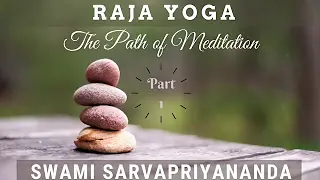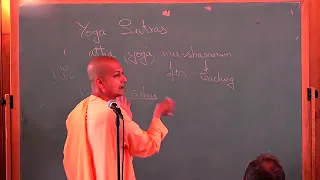

Raja Yoga / 'Royal Yoga"
The Path of Meditation
The Eight Limbs as outlined in Patanjali's Yoga Sutras
Below you will find six videos by various teachers on Raja Yoga.
Scroll down for more content on specifc aspects of the Raja Yoga Path.
Ashtanga ('eight limb')is the step-by-step approach to Yoga. Systematically the mind is analyzed and techniques are applied to achieve higher states of consciousness. Let us begin by starting with the basic framework of this Raja Yoga:
Eight Limb of Ashtanga Yoga
-
Yamas – Five Restraints (How we treat and respond to others - External Restraints)
-
Ahimsa: non-violence, non-harming with thoughts, words and actions
-
Satya: Truthfulness
-
Asteya: non-stealing, non-covetedness, lack of jealousy
-
Brahmacharya: chastity, moderation
-
Aparigraha: non-attachement
-
-
Niyamas – Five Observances (How we treat ourself - Internal Disciplines)
-
Saucha: purity, cleanliness (external and internal)
-
Santosha: contentment
-
Tapas: austerity, perseverance
-
Svadhyaya: study
-
Ishwara Pranidhana: worship of God or the Self or the Mantra – a complete surrender of the ego
-
-
Asanas – Steady Pose
-
Steady mind presupposes steady body.
-
Two requirements for every asana (posture): Sthira and Sukha (Stability and Ease)
-
-
Pranayama– Control of the Vital Energy (Breath Work)
-
The physical nerves as well as the astral energy tubes (the nadis) must be pure and strong enough to withstand various mental phenomena and disorientations that can occur during practice. In the process of turning the mind inward, old negativities may surface. By continuing to practice, their disruptions will lessen over time.
-
-
Pratyahara – Withdrawal of the Senses from Objects
-
Disconnecting the mind from the outgoing tendencies of the five senses: taste, sight, touch, smell, and hearing.
-
Reducing distraction
-
-
Dharana – Concentration
-
Concentrating the mind upon either an external object or an internal idea, to the exclusion of all other thoughts.
-
The first stage in medtation
-
-
Dhyana – Meditation
-
Meditation is defined as an unbroken flow of thought towards God or the Self or the Mantra, to exclusion of all other sensual perception.
-
The object of concentration eventually fades away and is not needed to experience a meditative state.
-
-
Samadhi – Super-Conscious State
-
It is sublime beyond description: beyond the mind to grasp. Samadhi transcends all ordinary, sensory experience as well as time, space, and causation. According to Yogis, Samadhi is connecting in the Oneness of life itself, and represents what all beings are moving toward.
-
_edited.jpg)




